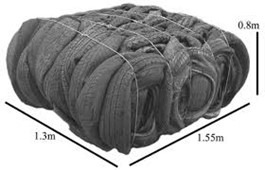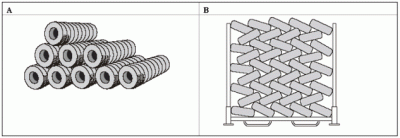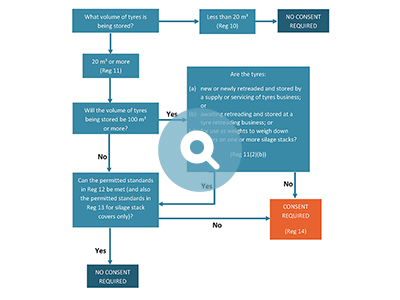Rules for outdoor tyre storage
The information on this page will help you determine if you require a resource consent for the tyres stored outdoors on your property, and any other actions you may need to take to comply with the National Environmental Standards for Storing Tyres Outdoors (NES-STO) which came into effect in August 2021.
Understand and implement the NES-STO
- Purpose of the standards
- Compliance timeline
- Determine if you need a consent
- Measuring the volume of tyres
- Guideline for tyre volume requirements
- Quick guide to the NES-STO for businesses and types of uses
- Disposal options
Purpose of the standards
The National Environmental Standards for Storing Tyres Outdoors (NES-STO) came into effect in August 2021.
Approximately four million used car tyres and one million used truck and other tyres are generated annually in New Zealand. The total number of tyres entering New Zealand each year is increasing.
A large number of end-of-life tyres will end up being stored outdoors in stockpiles due to the lack of markets for them. Storing or stockpiling tyres outdoors poses a risk of harm to the environment, human health and local communities – through the discharge of contaminants, fire risk (a low probability event with significant adverse effects), visual and amenity effects, and liability issues.
There is a very limited market for resource recovery of tyres once they reach the end of their usable life. This means end-of-life tyres accumulate, and there are incentives to dispose of tyres in the cheapest way possible. There has been a lack of effective regulation to deal with the outdoor tyre storage of end-of-life tyres and the associated risks. Government intervention was needed to introduce nationally consistent rules to address the risks of outdoor tyre storage.
The NES-STO is part of a set of initiatives to help solve the waste tyre problem in New Zealand and create a circular economy for tyres. The key initiative planned is regulated product stewardship. It will involve the tyre industry taking responsibility for the whole-of-life environmental impact of tyres.
More information on the NES-STO:
- Ministry for the Environment – overview information
- The NES-STO: Resource Management (National Environmental Standards for Storing Tyres Outdoors) Regulations 2021
- Users’ Guide
- Quick Reference Guide
Compliance timeline
The NES-STO was published on the New Zealand Gazette and came into force on 20 August 2021.
Under section 20A of the Resource Management Act (RMA), owners of properties with existing piles of tyres stored outdoors that do not comply with the NES-STO will have six months from 20 August 2021 (that is until 20 February 2022) to apply for a consent or comply with the NES-STO.
Determine if you need a consent
This diagram has been taken from the Ministry for the Environment’s NES-STO Users’ Guide – please refer to the full guide for further guidance.
If you do require a resource consent, see our resource consents page for information about our consenting process, pre-application advice, and how to apply. Contact us if you require further assistance.
Measuring the volume of tyres
This information has been taken from the Ministry for the Environment’s NES-STO Users’ Guide – please refer to the full guide for further guidance.
Once stacked, the volume of the tyre pile should be calculated as for any three-dimensional shape; length x depth x height, if the tyre pile is in a rough cube shape.

Diagram on how to measure the volume of tyre bales¹
¹Winter M, Correia A. 2019. The Use and Application of Two Contrasting Non-traditional Embankment and Pavement Foundation Materials. XVII European Conference on Soil Mechanics and Geotechnical Engineering.
Estimate the number of tyres. The 20m³ threshold is approximately 250 standard passenger tyres, and the 100m³ threshold equates to approximately 1,250 standard passenger tyres.
In the case of tyre bales, tyres are compressed into rough cuboid shapes, so the volume can be estimated by calculating depth x length x height (shown in Figure 1 in the above accordion). As tyre bales are compressed, the volume cannot be calculated on the number of tyres.
Approach 2 is only suitable for measuring standard car tyres and is not suitable for measuring larger tyres such as larger trucks, heavy machinery tyres or where you have a range of tyre sizes.
Where possible, tyres should be stacked to minimise the spread of tyres over the ground and keep them in a contained area.
Two common methods of stacking tyres:

Two tyre-stacking arrangements A: banded B: laced
²Source: National Fire Protection Association. 2003. Standard No 230: Standard for the Fire Protection of Storage
Guideline for tyre volume requirements
This information has been taken from the Ministry for the Environment’s NES-STO Users’ Guide – please refer to the full guide for further guidance.
| Quantity of tyres stored outdoors | Requirements |
|---|---|
| Total volume less than 20m3 on a property (Regulation 10) |
Storing tyres on the property is a permitted activity. Outdoor tyre storage of less than 20m³ on a property is still subject to general restrictions in sections 12, 13(1)(d), 15(1) and 17 of the RMA. which may be used by councils to take enforcement action to deal with the disposal of end-of-life tyres in certain circumstances, including when tyres have been buried on a site. For more guidance, see Ministry for the Environment, 2004: Enforcement Action under the Resource Management Act 1991 to Deal with Unauthorised Storage, Dumping and Disposal of End-of-Life Tyres. |
| Total volume 20m3 or more on a property (Regulation 11) | Storing tyres on the property is a permitted activity if:
(a) the general conditions in Regulation 12 are met; and (b) one or more of the following apply: i. the total volume stored on the property is less than 100m³ ii. The tyres are new or newly retreaded and are stored for the purpose of a business whose activities include the supply or servicing of new or newly retreaded tyres iii. The tyres are awaiting retreading and are stored on a property that is owned or leased by the business that will undertake the retreading iv. The storage of tyres is to weigh down covers on one or more silage stacks and the further conditions in Regulation 13 are met. Tyre storage outdoors that does not comply with any of the conditions above requires a resource consent from the consent authority as a restricted discretionary activity. |
| Total volume 100m3 or more per property. |
Resource consent is required as a restricted discretionary activity. However, the 100m³ limit does not apply to:
|
Quick guide to the NES-STO for businesses and types of uses
This information has been taken from the Ministry for the Environment’s NES-STO Users’ Guide – please refer to the full guide for further guidance.
Type of business
Permitted activity
- No added provisions
Restricted Discretionary (Requires Consent)
- No added provisions
Permitted activity
-
If the volume of tyres stored outdoors on the property is less than 20m³
-
If the volume of tyres stored outdoors is 20m³ or more for more than 72 hours and the tyres are new or newly retreaded, and the general conditions in Regulation 12 can be met.
Restricted Discretionary (Requires Consent)
- If the volume of tyres stored outdoors is 20m³ or more for more than 72 hours and the tyres are new or newly retreaded, and the general conditions in Regulation 12 cannot be met.
- If used tyres are stored outdoors for more than 72 hours in volumes of 100m³ or more.
Permitted activity
-
If the volume of tyres stored outdoors on the property is less than 20m³
-
If the tyres stored outdoors is 20m³ or more for more than 72 hours and the tyres are new, newly retreaded or awaiting retreading (‘tyre casings’) and regulation 12 can be met
Restricted Discretionary (Requires Consent)
- If the tyres stored outdoors is 20m³ or more for more than 72 hours and the tyres are new, newly retreaded or awaiting retreading (‘tyre casings’), then the general conditions in Regulation 12 cannot be met.
- If other used tyres are stored outdoors for more than 72 hours in volumes of 100m³ or more.
Permitted activity
- If the volume of tyres stored outdoors on the property is less than 20m³
- If the tyres are in use on top of a silage stack, the Regulation 8 exception for active use applies.
- If the storage of tyres is for their use as weights on silage stacks and the general conditions in Regulation 12 and 13 are met
Restricted Discretionary (Requires Consent)
-
If the volume of tyres stored outdoors is 20m³ or more on the property for longer than 72 hours and the purpose of the tyres is for use as weights on silage stacks, and regulation 12 and 13 are not met.
-
If the volume of tyres stored outdoors is 20m³ or more on the property for longer than 72 hours and
-
they are not for silage and are not in ‘active use’,
-
the general conditions in Regulation 12 are not met.
-
and the total volume of end-of-life tyres on the property is greater than 100m³.
-
Permitted activity
-
This is an exception applying to all properties.
-
Tyres being reused for sporting or recreation purposes, or for engineering, landscaping, drainage, or other construction purposes:
If the tyres are part of an existing reuse when the NES comes into force, and are part of a structure, then they don’t need to comply with the NES.
Restricted Discretionary (Requires Consent)
- Standard provisions apply to new ‘active use’ of used tyres that commence post august 2021.
Permitted activity
- Do not need to comply with the NES (Regulation 8)
Restricted Discretionary (Requires Consent)
- No added provisions
Permitted activity
- NES does not apply. Landfill rules in RMA council plans apply, or RMA Section 15(1)(d).
Restricted Discretionary (Requires Consent)
- No added provisions
Permitted activity
- NES does not apply. The RMA restrictions, council plan rules apply. Treaty Settlement Acts for rivers and The Litter Act 1979 may also apply.
Restricted Discretionary (Requires Consent)
- No added provisions
Disposal options
To check which district councils in Canterbury have facilities that accept tyres, please visit your local council’s website:


